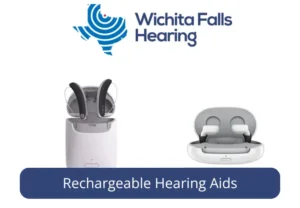In the realm of hearing technology, innovations are continuously reshaping how we experience sound. One of the most exciting advancements in recent years is the emergence of rechargeable hearing aids. These devices promise to combine convenience and sustainability, offering a glimpse into a future where managing hearing loss is easier than ever.
Understanding Traditional vs. Rechargeable Hearing Aids
Before delving into the benefits of rechargeable hearing aids, it’s helpful to understand how they differ from traditional battery-powered devices. Traditional hearing aids rely on disposable batteries that need frequent replacement. In contrast, rechargeable models utilize built-in batteries that can be conveniently recharged using a docking station. This distinction is crucial as it sets the stage for greater convenience and sustainability. Disposable batteries not only contribute to electronic waste but also involve ongoing costs and maintenance. In contrast, the rise of rechargeable hearing aids offers a greener alternative, diminishing the dependency on constant replacements and ensuring a seamless experience for users.
Moreover, rechargeable hearing aids incorporate advanced energy-efficient components that require less frequent charging and provide stable performance throughout the day. Traditional hearing aids, while effective, often fall short in situations where a battery change is not immediately feasible, potentially leading to periods of interrupted hearing. Rechargeable variants relieve users of this inconvenience, providing peace of mind by ensuring their device is ready to use whenever needed. As we pivot towards a more eco-conscious society, the transition from disposable to rechargeable equipment reflects a broader commitment to reducing our environmental impact.
The Advantages of Rechargeable Hearing Aids
Rechargeable hearing aids offer numerous benefits, including lower environmental impact, cost savings over time, and improved ease of use. Users no longer need to worry about carrying spare batteries or struggling with tiny compartments—simply place the hearing aids on their charger overnight for a full day of use. This feature appeals to those seeking to simplify their day-to-day routines while also engaging in more sustainable practices.
In addition to environmental benefits, the financial aspects of rechargeable hearing aids cannot be overlooked. While the initial cost may be slightly higher, the absence of recurring battery purchases can equate to substantial savings over time. Furthermore, modern rechargeable models often come with portable charging cases, allowing users to recharge on-the-go and maintain their active lifestyles with ease. Signia’s Pure Charge&Go IX offers advanced features, such as RealTime Conversation Enhancement, ensuring clear dialogues even in busy settings.
Rechargeable hearing aids also contribute to user comfort, especially for individuals with dexterity issues. The process of replacing small batteries can be challenging for some, making the ease of recharging a significant advantage. This added convenience encourages consistent use, ultimately supporting better hearing health and improved quality of life.
Advanced Features Enhancing User Experience
Beyond the basic convenience of not needing to change batteries frequently, modern rechargeable hearing aids come equipped with advanced features. These include Bluetooth connectivity for streaming audio directly from smartphones and improved sound processing for a richer listening experience. For instance, Signia’s IX Charge and Go offers seamless integration with devices, allowing wearers to enjoy media and conversations without interruption.
The significance of these advancements lies in their ability to integrate hearing aids into everyday life more seamlessly than ever before. Bluetooth connectivity means users can wirelessly stream music, podcasts, or phone calls directly to their hearing aids, turning them into personal audio devices. This feature transforms rechargeable hearing aids from mere assistive devices into multifunctional gadgets, enriching the user’s day-to-day interactions with technology. Additionally, these aids often include features like directional microphones and adaptive sound environments, enhancing clarity and comfort in various settings.
Addressing Common Concerns and Misconceptions
Despite their benefits, some potential users might have concerns about rechargeable hearing aids, such as battery life and performance consistency. It’s important to address these misconceptions by highlighting the robustness of current rechargeable technology and the strides made in extending battery longevity. Signia’s models, for instance, include efficient charging solutions that ensure you’ll never be caught off-guard.
It is essential to recognize that the development of rechargeable hearing aids has been guided by careful consideration of user needs and technological capabilities. Battery life, a primary concern for many, has been a key focus area, with most models supporting all-day use on a single charge. Furthermore, innovations like quick-charging features offer additional flexibility for spontaneous outings. The misconception that rechargeable options are less durable than their disposable counterparts is being rapidly dispelled as more people embrace these devices and share their positive experiences.
Looking Ahead: The Future of Hearing Aid Technology
The future of hearing aids is promising with potential developments in artificial intelligence and machine learning, leading to more personalized and adaptive hearing solutions. Rechargeable hearing aids are just the beginning, paving the way for innovations that make managing hearing loss simpler and more effective. The integration of AI could allow for automatic adjustments to the hearing environment, based on real-time analysis of soundscapes, further enhancing user experience.
Emerging trends suggest that hearing aids of the future will not only focus on improving auditory precision but will also incorporate features that enhance overall wellness. This could include monitoring vital signs or tracking fitness, merging healthcare technology with hearing assistance. With continuous improvements, these devices will likely become integral to personal health ecosystems, further emphasizing the importance of embracing rechargeable and sustainable options like those offered through Wichita Falls Hearing.
Embracing the Future of Hearing Technology
Rechargeable hearing aids represent a significant leap forward in hearing technology, marrying convenience with efficiency. As we look to the future, the ongoing advancements in this field promise even more sophisticated solutions that can enhance our daily lives while also being kinder to our planet. Embracing this technology now means stepping into a world where sustainable and user-friendly hearing solutions are the norm rather than the exception.


